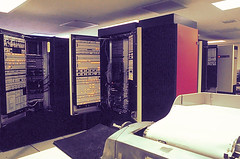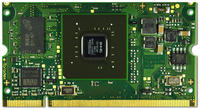 If you love computers and history as much as I do, you'll enjoy
The Strange Birth and Long Life of Unix - IEEE Spectrum.
If you love computers and history as much as I do, you'll enjoy
The Strange Birth and Long Life of Unix - IEEE Spectrum.
Such a wisely designed system to be pervasive after 40 years!
 If you love computers and history as much as I do, you'll enjoy
The Strange Birth and Long Life of Unix - IEEE Spectrum.
If you love computers and history as much as I do, you'll enjoy
The Strange Birth and Long Life of Unix - IEEE Spectrum.
Such a wisely designed system to be pervasive after 40 years!
Practical takeaway: stacked memory is clearly one of the killer apps for 21st-century 3D IC assembly.
If you're a Synopsys tool user, please consider submitting a paper today for presentation at SNUG Silicon Valley. You can propose a paper by filling out a form and writing an abstract. Besides benefiting the engineering community at large, you'll develop your professional skills and raise your profile. We on the Tech Committee will help you!
Please visit the Call for Papers Web Page to check it out and submit your idea.
I'm thinking to write a post on immigration and careers, but for now let me point you to two provocative articles I recently read:

How does it apply to our world?
"As it turns out, you can't get your data out of our EDA tool ..."

 For several years, Synopsys has a group of folks participating in social media (blogging, tweeting, etc.).
Why, they've even written a book about it!
For several years, Synopsys has a group of folks participating in social media (blogging, tweeting, etc.).
Why, they've even written a book about it!
If you've heard about Twitter but don't know what it's all about, here's their article to succinctly show you the answers: The Listening Post » Twitter Helps Engineers.
What tweets might you find related to EDA on Twitter? Here's a real-time display:
 Tech news has had a plethora of stories about Steve Jobs and Apple since Dear Leader announced he was stepping down as CEO.
Tech news has had a plethora of stories about Steve Jobs and Apple since Dear Leader announced he was stepping down as CEO.
The SF Chronicle has a nice profile of one of the less publicized but vitally important talents at Apple, the head of product design: Apple's product vision falls to Jonathan Ive.
Update: Perhaps the San Jose Mercury News follows my blog, because shortly after this post, the newspaper of Silicon Valley came out with their own profile of Mr. Ive, Apple's design wizard has not left the building - San Jose Mercury News.
Four years ago, I presented my original CAD Engineers' Bookshelf. I've put together an updated list here of the subset of books that I refer to most often. Since some titles have been updated, latest editions are listed here.
Another update since 2007 is that alternative formats are widely available for these books. You can go directly to the source at O'Reilly Media and purchase Ebooks formatted for all the popular e-readers. It's very convenient to be able to download formats that look great on your Computer, Kindle, or iPad.
Without further ado, here's the 2011 version of the bookshelf.
It's all Perl, which is testimony to both Perl's power and it's inscrutability!
Ever listen to This American Life? Ira Glass is a great story teller. This week's episode is very relevant to our industry.
It's on the long side. You can listen to it here, or do as I do and load it as a podcast onto your personal media player of choice. Then you can listen while washing the dishes, walking the dog, etc. Multi-tasking!
Who's your (least) favorite EDA/IP patent troll?
 A well-deserved congratulations to Dr. Morris Chang, recipient of the 2011 IEEE Medal of Honor.
IEEE Spectrum magazine has published a fascinating profile of his professional life in
Morris Chang: Foundry Father - IEEE Spectrum.
A well-deserved congratulations to Dr. Morris Chang, recipient of the 2011 IEEE Medal of Honor.
IEEE Spectrum magazine has published a fascinating profile of his professional life in
Morris Chang: Foundry Father - IEEE Spectrum.
The article quotes numerous industry luminaries to frame his impact. It's hard to overstate what Dr. Chang's accomplishments have done for so many of the industries that we work in: fabless semiconductor, EDA, ASIC, ... I found the article to be full of fascinating tidbits, such as
I'm happy to be an Apple customer instead of reporting to Steve!
 Wow, is "FinFET" happening already?
It will soon, according to
Intel putting fins on at 22-nm.
Wow, is "FinFET" happening already?
It will soon, according to
Intel putting fins on at 22-nm.
Intel will ramp manufacturing of these devices next year for their 22nm process shrink of Sandy Bridge CPUs. That appears to be a full process generation ahead of leading foundries such as TSMC, and the low-power advantage would help Intel become more competitive in the elusive mobile market.
 I'm not sure which is the right analogy, but in reading
A5: All Apple, part mystery,
I find this article to (1) be an interesting survey of the state of Apple silicon, and (2) an article that goes on and on but doesn't contain any factual information.
I'm not sure which is the right analogy, but in reading
A5: All Apple, part mystery,
I find this article to (1) be an interesting survey of the state of Apple silicon, and (2) an article that goes on and on but doesn't contain any factual information.
Apple's wall of silence is unprecedented in the industry. While much has been said about Steve Jobs' Reality Distortion Field, equally impressive is the control that Apple exhibits over employees and suppliers to suppress all leaks. Have you seen many Apple presentations at industry conferences?

Some pretty cool very early computer history from this obituary: Jean Jennings Bartik, a Computer Pioneer, Dies at 86 - NYTimes.com. Also, Jean Bartik on Wikipedia. Greatest Generation Pioneers, thank you for your contribution to the United States and the Computing profession.
The nominees in EDA Tools and ASIC Technologies are
Looking back at 2010 EDN Innovation Award winners, there were multiple categories of EDA-related awards, and thus many more EDA nominees. From each category, the winners were
Props to John Cooley for his article looking at Apache Design's history and products. It's been 10 years since the last EDA IPO? Surprising and troubling. Let's hope it's less than a decade for the next one.
Email from John:
http://www.deepchip.com/gadfly/gad031811.html
INDUSTRY GADFLY: "A brief history of Apache and its IPO"
by John Cooley
On Monday, Apache Design Solutions, Inc. (APAD) filed to IPO for
$75 million as a publically traded stock on the NASDAQ.
The last company to successfully IPO in EDA was 10 years ago. It
was Magma, which raised $63 million back in 2001....
http://www.deepchip.com/gadfly/gad031811.html
I was delighted to find this couple of blog posts by UC Berkeley Computer Science professor David Patterson, one of the giants of computer architecture (and founding member of the RISC Fan Club):
If RISC and CISC start to look more like one another as they steal good ideas from each other, the architecture won't determine the "winner". Rather, it will hinge on other vital issues such as process technology (Intel wins) and openness (ARM, MIPS lead here).
Finally, if I may add a sophomoric comment, doesn't Prof. Patterson's mug shot remind you of Patrick Stewart (Captain Picard)?

|

|
Before that, the only other book I had seen on EDA was about the start of the ASIC industry,
Silicon Destiny: The Story of Application Specific Integrated Circuits and Lsi Logic Corporation,
which is pretty hard to find.
As a bonus, the well-produced DAC 2009 video features company executives in a music video with cheesy parodies of some classic rock songs. I'm amused, but Al Yankovic need not worry.
Props to DeepChip.com for leading to my discovery of these gems.
I got to wondering -- which tool has the biggest lock on a major piece of the EDA tool constellation? (I originally wrote "monopoly" instead of "franchise", but don't want to connote market manipulation.) From my perspective, three come quickly to mind
You may have other ideas, and I'd love to hear other nominations. Of these three, I think a good case can be made for Design Compiler having the strongest position. The other tools have large market shares, but also competition determined to make inroads.
Who might chip away at the synthesis gorilla? The old and new rivals are Cadence RTL Compiler and Oasys Real Time Designer. Just published on ESNUG is this "marketmonial" (I need a word for a marketing-inspired testimonial): DeepChip.com: "An Oasys RealTime Designer vs. SNPS DC-Topo/DC-Graphical benchmark . A couple of things that I especially like about Oasys' approach:
Time will render the verdict, and the EDA battlefield is littered with past attacks on DC's franchise, but we need competition in all tool areas to continue advancing the state of the art.
Intel, if you need reliable designs to support your latest CPUs, there used to be a variety of companies in the chipset business.

January 2011 had more than its fair share of bad news for Intel, culminating in a very expensive recall of their newest chipsets because of a design defect. Most of the press coverage focused on the financial hit, but us design engineers are dying to know "what happened?". What's most interesting is that the problem isn't a defect that manifests itself right away, but one the causes the component to deteriorate over time. At first, I thought "electromigration". But the best speculation/analysis I've seen this early has been from Mike Demler, who shares his theories in Price for a new SATA I/O $700M. A complete AMS verification? Priceless! and If ever EDA needed a ($700M) proof point on their value....
If that's the root cause of this problem, it's another data point showing fraying at the edges of our tried and true EDA suites: tools are not available or mature to help with analyzing reliability, materials, packaging, etc.
Update: Thanks to a link from Steve Leibson, I came across this very specific description and analysis of the problem.
 If you followed the Consumer Electronics Show news at all last week,
you heard a lot about ARM, ARM, ARM.
Mindshare-wise, it would appear to have Intel on the defensive.
(I wonder how Intel feels about selling off their StrongARM now?)
If you followed the Consumer Electronics Show news at all last week,
you heard a lot about ARM, ARM, ARM.
Mindshare-wise, it would appear to have Intel on the defensive.
(I wonder how Intel feels about selling off their StrongARM now?)
I plan to learn more about ARM's architecture and products. For today's history lesson, Birth of a world beater features one of the original ARM designers.
I'm curious to learn the technical merits of the ARM architecture. Is it inherently superior? Or is the main advantage the scads of software eco-system available, with low-power coming from standard implementation and process tricks?
Technical superiority and business success don't always go hand-in-hand, anyway.
I've attend HOTChips before, and I was amused how all the microprocessor experts
there bemoaned x86's incredible success, even though they knew it was inferior to
[insert your favorite CPU here];.
x86 was just good enough to survive, and had been in the right place at the right time.
Is now the time for ARM?
Early in my career, I got to visit the IBM Burlington fab when they were introducing a brand-spanking-new technology called "CMOS". Little did I know that would be my last chance to set foot in a semiconductor fab. So, I'm always fascinated to see how things look today. Some things I learned:
 Created by several fellow EDA bloggers,
this is an intriguing new EDA/Chip Design site
worth visiting and contributing to.
Created by several fellow EDA bloggers,
this is an intriguing new EDA/Chip Design site
worth visiting and contributing to.
I know that several bloggers and old ASIC hands wanted to put together an open community for sharing opinions and experiences, and this is the most substantive effort to date. (I tip my hat to John Ford's now-defunct "DFT Digest" site, which was a pioneer in this area.)